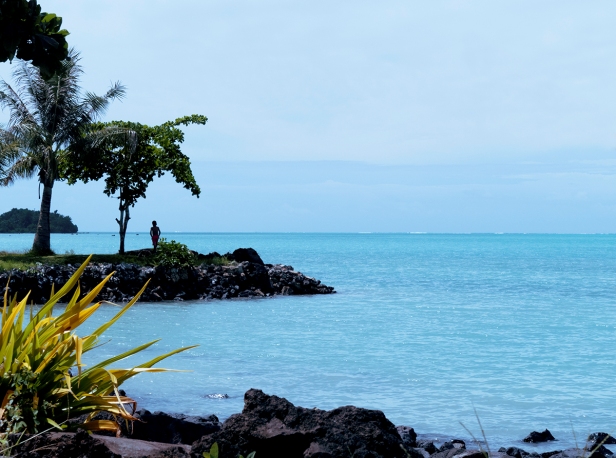
5-12 Dec 2014. In the early hours of December 5th we boarded a Fiji Airways flight from Hawaii to the Polynesian island nation of Samoa. Several hours later, jumping into the taxi provided by our hotel, we set off with great anticipation for our little self-contained cabin by the beach not far from the town of Apia.
Searching for a place to stay in Samoa, as always we were looking for something about mid range, close to amenities, Wi-Fi if possible, and most important of all, good reviews. Of course when we’re staying on a South Pacific island we’re also looking for a place by the beach. We found Taumesina Hideaway.
Taumesina Hideaway, on Booking.com is described by the owners thus:
Surrounded by swaying palm trees, Taumesina Hideaway is located directly on the beach. Guests can enjoy a free breakfast and stunning ocean views from their private patio. It is a 10-minute walk from Apia town centre.
You can enjoy a refreshing swim in the ocean, or simply laze in the sun on a comfy sun lounger. The on-site tour desk can arrange a variety of local activities including snorkelling.
Faleolo International Airport is a 35-minute drive away.
Sounds perfect doesn’t it? The reality was something different. The airport is over an hour away, it is actually a 45-minute walk to town, our cabin was across a ‘garden’ and across the road, and across another ‘garden’ so not right on the beach, and was basic in the extreme. I’m okay with basic. Don not so much. What I was not okay with was this:
This new construction stretched the whole length of the bay directly in front of Taumesina Hideaway. The sense of entitlement of the wealthy conglomerate, variously from Australia or New Guinea or both, that would do such a thing made me angry. I suppose it matches my own sense of entitlement to an uninterrupted ocean view when that is what has been advertised. It made me sad for the owners of Taumesina Hideaway. And it was clear that we would be looking immediately for alternative accommodation.
We did stay that one night and next morning at breakfast I talked to the owner about it. I asked if she had received compensation for the thorough and permanent loss of her beautiful sea view. Her reply was ‘not me, the village’. It had been decided by the matai (the village chiefs) to allow the development essentially in exchange for employment. Local people are being employed on the construction, and local people will be employed at the resort once it is completed. Also the hope is that the resort will bring more tourists to the village and more development to the area. Already a small store has opened close by, and a café is expected soon. Such is the price of progress. One can hardly blame the Samoans for wanting more prosperity. Perhaps when the resort is complete and its gardens grown it will not be such a stark and uncompromising interruption to the natural beauty of the area.
Our new hotel, not on the beach but closer to Apia, was luxurious in comparison, and had a restaurant serving enjoyable, if not outstanding, meals. At Taumesina Hideaway there was no such convenience, which wouldn’t have been a problem if it really had been only a ten-minute walk to town and thus to restaurants.
Once established at the new hotel after this inauspicious beginning we began exploring Samoa, and discovered one of the most wonderful places we’ve been to.
About half way between Hawaii and New Zealand, Samoa consists of two large islands, Upolu and Savaii, and several small islets. Not be confused with American Samoa, which is part of the same group of islands but is an American territory, Samoa gained independence from New Zealand in 1962. The population is estimated to be something over 190,000 and the only town of any size is the capital, Apia on the island of Upolu. The most dominant building in Apia is the Catholic Church, a grand edifice right by the water.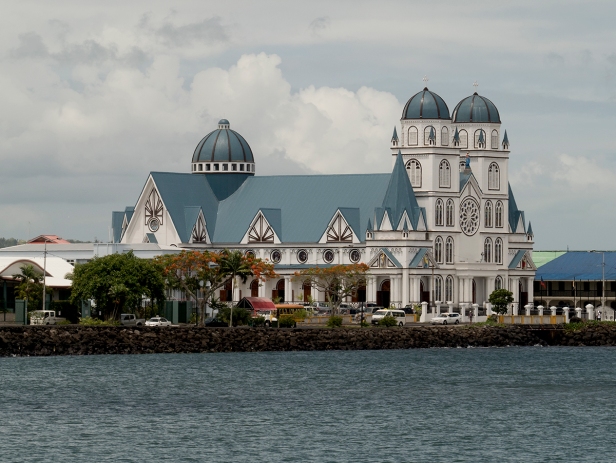
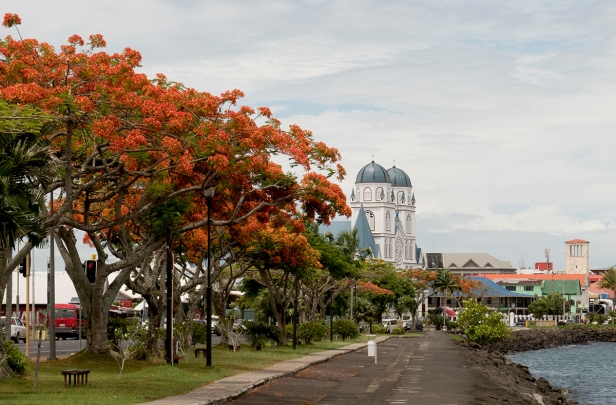
We find the people to be incredibly welcoming and friendly wherever we go. At the market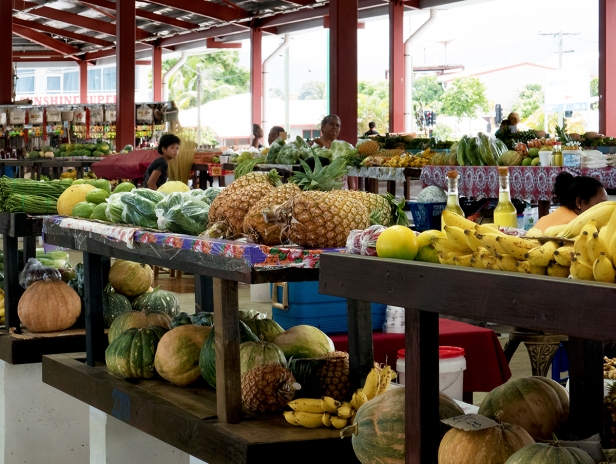
I am photographing this family when the woman behind sashays up to join in, making everyone laugh,
while the older daughter quietly sits attending the family souvenir stall,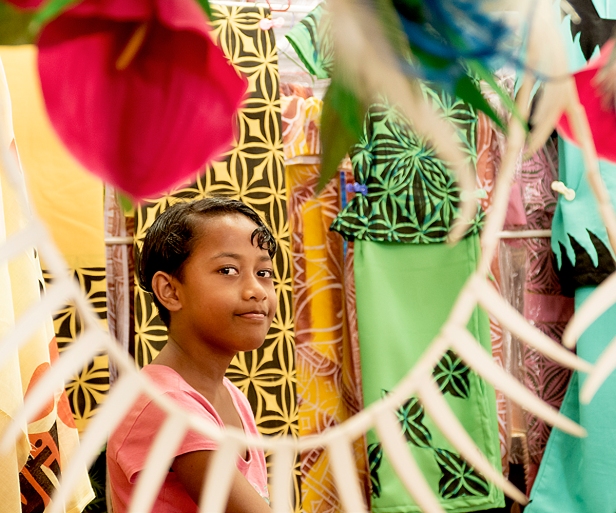

and the younger daughter shows she has already learned the requisite peace sign for photographers.
This young girl shyly asks to be photographed.
One woman I spoke to said she comes in with her harvest every day by bus and taxi from her farm near the airport, a journey of well over one hour. At the end of the day she returns by taxi. Given the deeply family-oriented nature of Samoan culture it’s probable that her family farms the land while she is gone all day.
The flower sellers are clustered together. One of them is making beautiful arrangements for funerals. Each arrangement is a tier of ‘flowers’. The triangular backing is large green leaves, with white ‘petals’ made from ribbon held on with toothpicks, some gold spray paint, and finally at the centre of each ‘flower’ a small orchid that she has grown in her own garden. Many Samoans grow flowers so they can contribute to the church flower arrangements.

Over the years Samoans have emigrated to New Zealand, Australia and California in order to find work, sending what they can back to their families. Tourism now accounts for about 25% of the economy, while agriculture and fishing are the main sources of income. Given that these are isolated islands in the middle of a vast ocean, it’s not surprising that fishing would be integral to their way of life, and that almost everyone lives in villages ringed around the coast.
Fishing boats in Apia Harbour.
At the local fish market I find the greatest variety of colourful fish I’ve ever seen at a market. The really big fish are tuna.


There’s another market area by the water just along from the big church,
and a joyous woman there spontaneously puts on a show just for me, dancing the local Polynesian dance while I photograph her.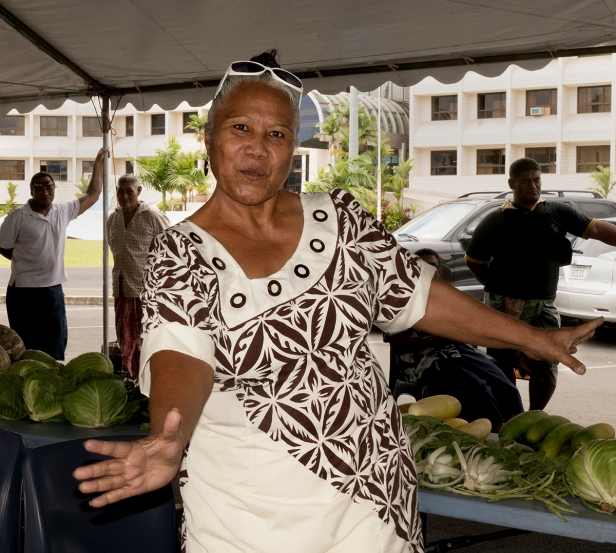
These baskets are woven from coconut palm leaves and are carried one on either end of a pole across the shoulder.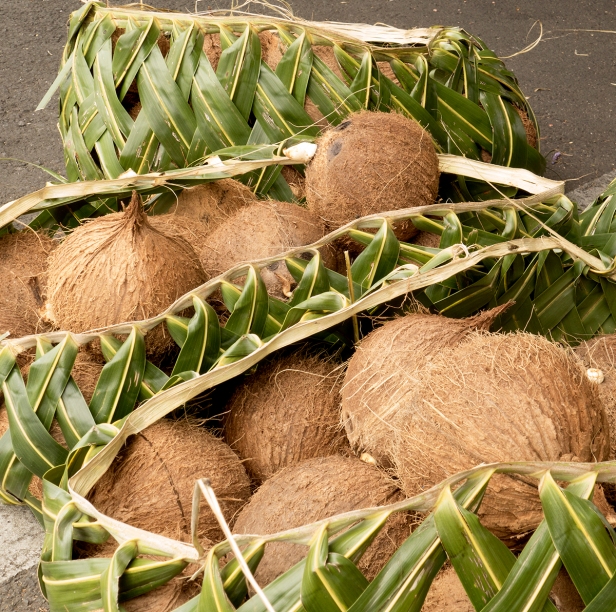
Tropical hospitality,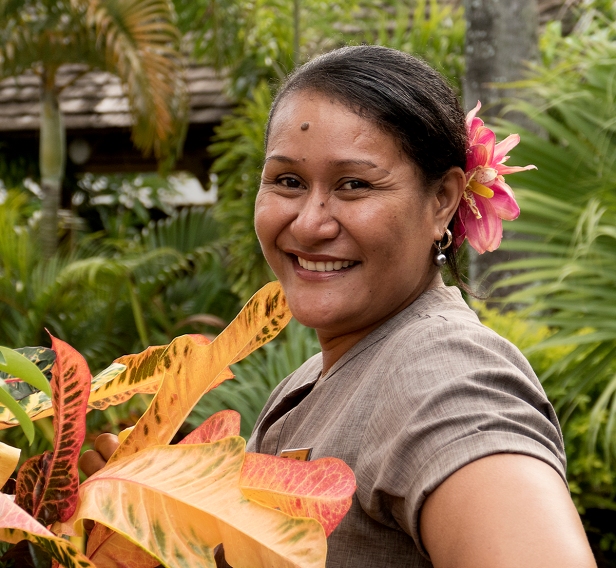
tropical flowers,
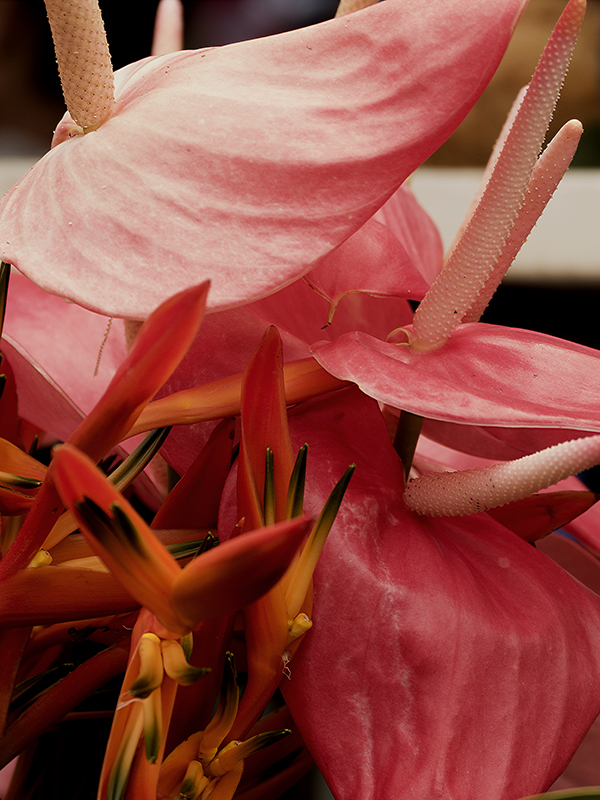
tropical foliage,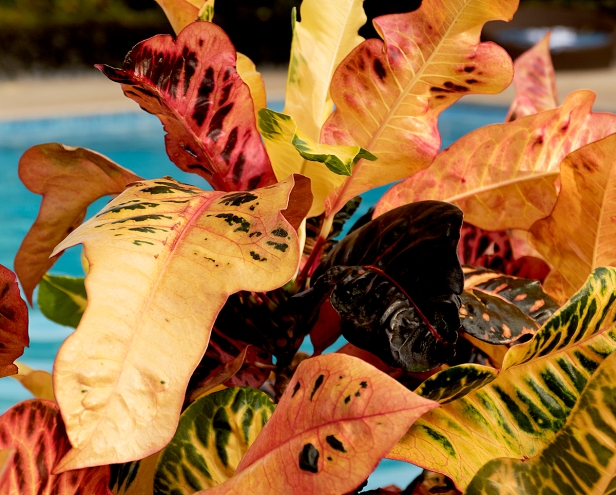
and tropical fruit – rambutans. Inside that easy-to-peel spiky-looking exterior is delicious soft translucent white fruit.
It’s hard not to be dazzled by the brilliant colours. Even the buses are colourful, creative, truly imaginative works of art. The buses travel all over the island and almost every one is different. There’s Kingdom Transport, and Tuisamau Transportation, and a bus called Lady Elizabeth, and Sunrise Transport, and my favourite, Skippy Bus.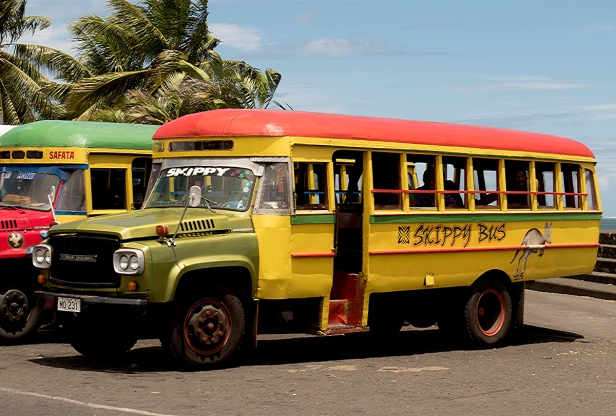
This collection of photographs is on the wall in a café near the market.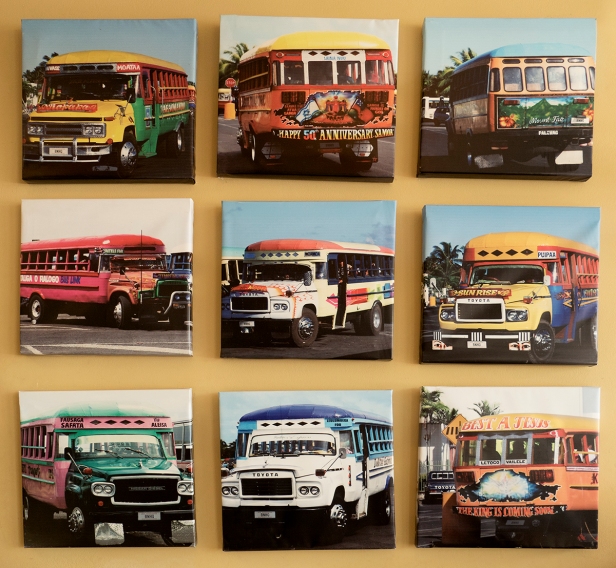
It’s hard not to be charmed by the Samoan people who are invariably friendly and welcoming. During our time there we explored two of the islands, visited with a family during a torrential tropical downpour, went to a truly mind-blowing church service, went swimming in a lava hole 30 metres below ground level and attended a traditional dance performance. Villages, houses, streets bordered by flowers, forests, waterfalls, language and lifestyle. All this to come in the next two posts.
All words and images by Alison Louise Armstrong unless otherwise noted
© Alison Louise Armstrong and Adventures in Wonderland – a pilgrimage of the heart, 2010-2015.

very nice 😀
LikeLiked by 1 person
Thank you so much.
Alison
LikeLiked by 1 person
So far away from where I live and yet it does look a bit like home. It’s such a pity about that new construction. That happens here in the Philippines too, when people, because of poverty, “sell out” their resources in exchange for employment. It’s horrifying for us visitors but sometimes it’s a choice between that and their family not being able to eat and go to school. 😦
LikeLike
I’m not surprised you’d find it like where you live – there’s a tropical theme that runs around the equator. It’s a very rich and deeply colourful landscape.
I don’t blame the Samoans for their deal. It will hopefully bring them some prosperity and who can blame them for wanting that. Nothing’s ever black and white. And the prospect of enough money for a better lifestyle is bound to be enticing.
Alison
LikeLiked by 1 person
What a shame about the bad start, clearly the hotel didn’t live up to how it was advertised. I use booking.com as well and in most cases the descriptions have been pretty accurate. Did you write a review on Taumesina after your stay?
But otherwise Samoa does look like a beautiful place. Those colourful buses also remind me of jeepneys in the Philippines. And the people – as ever your portrait shots are fabulous! I think the fact that they’re always so willing to have their pictures taken (no matter where they are) says something about your warmth and friendliness.
LikeLiked by 1 person
It was not a wonderful start, but I was pleased to be able to talk to the owner and find out the story and that hopefully eventually the local people will benefit from the development. They should change their advertising to at least give the correct distances to town and the airport. I don’t think we wrote a review. Don does fairly often, but maybe not this time. I feel for them. I don’t want to go online and trash the place and make their business even worse. OTOH I suppose it would be a service to our fellow travellers.
Samoa is a beautiful place, especially once you get out of Apia. Driving around the island it is village after village with beautiful gardens – I’ll share it in the next post.
Thanks re the photos. Sometimes I’ve been chastised for taking photos, but not often. Mostly I just talk to people first – even if it’s only in sign language.
Alison
LikeLike
Great article and as always, photos. These portraits convey so much about the country. Why do I have the feeling that the Samoan people’s friendliness and warmth has perhaps also to do with the way you and Don relate to them?
LikeLike
Thanks Helga. I think it’s true to say Don and I approach people with curiosity and openness. It’s also true to say Samoans are really really friendly. More so than Andeans for instance. The Andean people are more reserved. Indian people love to be photographed and will jump in front of the camera. Having been to quite a few different places now our experience of the Samoan people is that they just love that you have chosen to visit their country and welcome you with open arms.
Alison
LikeLike
Hello Don and Alison,
Thank you so much for sharing this beautiful post from a remote corner of our planet 🙂
Hope you had a great beginning to the new year 🙂
So nice to see “an all inclusive guide” to Samoa here.
At the same time it’s so sad to see the man made structures spoiling the natural beauty of the place.
It’s really nice to see the smile on people’s faces and I feel you had a great time 🙂
Have a beautiful day ahead 🙂
LikeLiked by 1 person
Thank you so much Sreejith. Despite the man-made structures, there’s still plenty of Samoa to see that is untouched by the big developments. And yes, we had a wonderful time there. We really loved it. Thanks for your kind thoughts. Hope you have a wonderful new year too.
Alison
LikeLiked by 1 person
Outstanding. Photos are also excellent, extraordinary.
LikeLike
Thanks so much Mintu. I’m glad you enjoyed it.
LikeLiked by 1 person
You are most welcome. Have a good day.
LikeLike
What a beautiful, colourful country with a lot of smiling positive people around (as I guess from your photos). If I had a bucket list for the places I want to visit, Samoa would definitely be on it. 🙂
LikeLiked by 1 person
Yes – a beautiful colourful country with many smiling people despite their hardships. It is not a wealthy country in money but it is rich in culture and family life and natural tropical food resources. Dental care is pretty much non existent, but mostly they seem to be healthy and have plenty to eat and strong family support. Do put Samoa on your bucket list! 🙂
Alison
LikeLike
Am excited to hear about your “mind blowing church experience” in your future posts. MORE MORE Happy travels to both of you in 2015 – Lee
LikeLike
Thanks Lee, and patience – the church service will come soon. I want to do a post on religion in Samoa. But next I’ll write about our journeys around the islands.
Happy travels to both of you too.
Alison
LikeLike
Great experiences on the whole in Samoa. It looks so amazing, I can only dream of getting there. The photos are awesome too. People should use this as a guide. 🙂
LikeLike
Thanks Lee. It is amazing, definitely worth visiting.
Alison
LikeLike
Great colour of picture as well as gorgeous smile of the poeple. I love it.
n.
LikeLike
Thanks so much Nina. It’s a really beautiful place.
Alison
LikeLike
You clearly had a rough start on your trip to Samoa, but I’m glad it all ended up as a great trip. I’m also really glad that you talked to the owner of Taumesina Hideaway so you learned what really happened to give us all a better perspective on why the new constructions were there, obstructing the otherwise incredible view of the Pacific Ocean from the hotel.
Alison, it sounds like Samoans are some of the friendliest people on Earth! I like the fact that some of them actually asked you to take some photographs of them, even danced!
Speaking of Fiji Airways, it’s one of the airlines I really want to fly with, especially after they updated their livery, incorporating Fijian masi. How would you describe your experience flying with them?
LikeLike
Well it wasn’t the best start, but not that rough really, and yes, it all ended up being a great trip. So glad we went there. I too an glad I got to talk to the owner of Taumesina. It did give me a better perspective.
I do think that Samoans are some of the friendliest people in earth.
Fiji Airways is great! One leg (Hawaii to Samoa I think) was in a turboprop rather than a jet, and I was a bit nervous about 5 hours flying across the Pacific in a turboprop, but it turned out to be a brand new plane, and a completely comfortable flight. Don’t remember the food. Which I would do if it was really bad so it must have been okay. Samoa-Fiji, and Fiji-Sydney flights were in jets.
Alison
LikeLike
I would love to visit Samoa. After loving Hawaii and Fiji so much, I want to explore more of the Pacific Islands and their welcoming culture
LikeLike
Samoa is beautiful and definitely worth visiting. We’ve also been to Raratonga (the main island of the Cook Islands) which we loved.
LikeLike
Too bad about the hotel but Samoa is so beautiful, thankfully. Be well, and wishing you both the best for 2015. ❤
LikeLike
Yes, Samoa is very beautiful. We’re so glad we went there.
Wishing you all the best for this brand new year too.
Alison ❤
LikeLike
What was ‘mind-blowing’ about the church service Alison, may I ask?
LikeLike
Patience Hariod, patience. There will be a whole post about it. Coming soon but next post will probably be a nomadic life post (catching up on the inner journey), and then a post on Samoan island life, and *then* the post about the church service and the religion of Samoa 🙂
Alison
LikeLike
After a rough start, it all sounds lovely. I love the fact that people were so open and shared so much of their lives with you. Kind of funny (although I’m sure not for you at the time!) that the 10-minute walk to town was really 45- in The Bahamas we have learned to tack on at least 20 minutes to proposed walk times. =)
Can’t wait to hear more!
LikeLike
Yes it really is a lovely place. Well worth a visit, and the people respond to curiosity. They all seem so pleased that we chose to visit their country.
Good point about tacking on an extra 20 mins to walking time. It must be a tropical hot climate thing. I’ll keep it in mind.
Alison
LikeLike
beautiful photos Alison of your Samoa adventure. We’ve just landed in Guayaquil on our yearly Ecuador adventure.
LikeLike
Thanks Judy. Have a wonderful time in Cañar, and everywhere else you go in Ecuador.
Alison
LikeLike
Great post! It’s so interesting to hear about the culture and life from the locals’ perspectives. I read so much about other South Pacific islands like Fiji and Tahiti, it’s nice to learn about one of the ‘lesser-known’ destinations!
LikeLike
Thanks so much Laura. There’s more to come on Samoa. It was a wonderful place to explore and not as touristified as some of the other South Pacific islands. We went to Fiji after Samoa and enjoyed that too though we didn’t do the usual things there.
Alison
LikeLike
For a second, I thought that the picture of the Catholic church was a drawing. Beautiful photos!
LikeLike
Thanks so much Saana. That church is a beautiful building. Wish I could draw that well lol 🙂
Alison
LikeLike
Your photos are sumptious and fabulous! Love and can soooo relate to your abode challenges, I’ve just read the recent reviews of the place we are going, “not old and tired, but exhausted over the water bungalows….” Yikes, well at least I can jump in the ocean!!! Ahhhhhh, the joys of travel!!! 😉 Love, love, love your posts!
LikeLike
Thanks so much Cindy. It’s a sumptuous place! OMG not old and tired, but exhausted! LOL Yes, just jump into the ocean! Thanks for your kind words! It’s always so encouraging.
Alison
LikeLike
Great photos. That church is probably the most glamorous building in Samoa. I get the impression there are some real socio-economic challenges in Samoa for long time locals there…not from your blog but from elsewhere.
LikeLike
Thanks Jean. Yes, that church is definitely the most glamorous building in Samoa. It’s not a wealthy country but people seemed generally healthy, not that desperate feeling of poverty. Still I suspect medical care could be better, and dental care seems non-existant, and many live subsistence lives I think.
Alison
LikeLike
It’s sad to hear of another unspoiled paradise being tarnished by development and modernization. I do understand the need for greater prosperity in places like Samoa, but it should be possible to build resorts or other tourist facilities that are in harmony with the environment and accentuate natural beauty and native traditions, as opposed to diminishing them.
Part of the problem with a lot of developments is that the bulk of the profits go to the owner, not to local employee. When Trump puts up a hotel on a tropical beach in a foreign land, I doubt that the well-being of his employees is his foremost concern (not to say he doesn’t pay well).
It would be nice if tourist development was locally-driven and bottom-up in countries like Samoa – rather than driven by the greed of the wealthy But in reality that could be difficult if the resources needed are lacking.
LikeLike
“It should be possible to build resorts that are in harmony with the environment and accentuate natural beauty and native traditions” THIS! Well said Gayle. And I have seen such resorts – one even in Samoa that I saw from a distance. So it is possible. The one at Taumesina is such an eyesore, so completely out of harmony with the environment. There’s a kind of rudeness to it. And disrespect. So sad.
And yes, it would be nice if tourist development was locally driven but I think it’s a bit of a fantasy unfortunately.
Alison
LikeLike
Well, I find myself most intrigued with Samoa from the snippet of information and photos provided so far. More drawn to this island paradise than I was expecting to be. Perhaps such color and brightness in the winter draws me in? I will look forward to “experiencing” the additional posts about Samoa.
LikeLike
It’s a beautiful island paradise. I’m glad I enticed you. Future posts will entice you more I’m sure. Our travels around Manono and Upolu islands, away from Apia and into the forest and the villages were filled with beauty.
Alison
LikeLike
We had a recent experience with an online rental in Cartagena, Colombia from AirBnB that was less than satisfactory, too (try NO MATTRESS on the bed!) although it was across the road from the beach and close to restaurants. Luckily AirBnB backed us up but it definitely starts you off on the wrong foot! Samoa looks amazing and I’d love to visit! Anita
LikeLike
No MATTRESS! Wow, that’s audacious of them. Or something, anyway. I was in Cartagena about 40 yrs ago, staying in a lovely little hotel on the beach outside of the main town. Lovely.
Samoa is definitely worth a visit. Beautiful place, and very peaceful and gentle.
Alison
LikeLike
An ethical dilemma, (to tell or not to tell that one would have to travel at 160 km/hr to reach town in 10 mins), and beauty all around. Sounds like life on Planet Earth. I don’t want to crash your future post, but the church in the photo– did you learn much about its architectural origins or vintage?
I couldn’t tell from the one or two photos here if I felt it really “fit” the place or not. I couldn’t tell– and I didn’t look deeply enough perhaps– if it was more of a modern attempt to recreate a depth of structure an older building may have had naturally? It seemed like an attempt to have a deeper meaning, as if an effort was made, but like it somehow ended up a little stale? It almost looks like it is trying a tad too hard, and not quite being responsive to its surroundings or something. But I’m curious what you felt about it’s presence.
Some of those churches you saw in Cyprus were cow stalls on the outside, but they belonged…
Michael
LikeLike
We didn’t learn about the history of the church. It didn’t remotely ‘fit’ the place but rather stuck out like a sore thumb. I’m pretty sure it’s a modern building. Definitely trying too hard – ‘We are the biggest and best!’ and not at all responsive to it’s surroundings. You guessed right. I like it as a building. I suppose we ‘should’ have gone inside but weren’t drawn to at all.
Alison
LikeLike
You should have. It is absolutely spectacular inside. The intricate detail of the craftsmanship paid homage to Samoan designs and artistic concepts. It does stick out like a sore thumb, but it is an improvement on the old cathedral and the work to shore up the Mulivai stream next to it is a major improvement in times of flood prevention during the annual flood season.
The original church was built in the 19th century, and was used as a point of reference for ships entering Apia harbour.
LikeLike
Now I’m so sorry we didn’t go inside. It sounds as if we missed something quite wonderful. Thank you for sharing this. At least maybe I can find some pictures online to see what we missed.
I think it’s a beautiful building even if it doesn’t really fit in with its surroundings. I should have realised that the beauty would continue inside. I think we were a bit jaded after visiting so many churches in South America.
Alison
LikeLike
Such lovely smiles, Alison. I once spent time on Fiji when I travelled through the South Pacific but never made it to Samoa. There is something about a tropical island, though… 🙂 Curt
LikeLike
Ah yes, there is something about a tropical island, a certain vibe, a certain warmth that is not found elsewhere. We went to Fiji after Samoa and found many similarities though Fiji is more developed and touristified.
Alison
LikeLiked by 1 person
Fiji was still somewhat natural when I went there in 1976. It always worries me that I will go back to some of the places I’ve visited and find them totally changed. –Curt
LikeLike
Hi Alison, thanks for giving me an insight into the Samoan way of life. Beautiful photos and they portray so well the friendliness of this people. It is sad about the undesirable constructions that ruin the character of this amazing paradise. I will have to visit one day. Safe travels!
LikeLike
Thanks so much Gilda. I agree it’s sad about the construction, especially like this one that in no way blends with the environment, but the people are wonderful, and very welcoming, and most of the islands still show the Samoan way with beautiful scenery and forests and gardens and their lovely open-air houses.
Alison
LikeLike
It looks lovely Alison, and that has to be one of the most colorful fish markets that I’ve ever seen. Too bad about the hotel. We use booking.com as well, and usually have good results. We don’t always do reviews for our hotels/apartments, but if the ads are misleading we always do. With a few bad reviews, hopefully, the hotel will get the message and clean up their act. ~James
LikeLike
Yes, it is lovely. We’re so glad we went there. Beautiful surroundings and beautiful people.
Okay you gave me a nudge about a review. It’s really a dilemma. They should at least adjust the times to town and airport even if they can’t do anything about the construction. I think I’ve convinced Don to write one 🙂
Alison
LikeLike
Samoa is so beautiful, everything there! I wish I could visit it soon…
LikeLike
Yes, it is a very beautiful place. I hope you get to visit soon.
Alison
LikeLike
How wonderful. What a great find. Love the colours, the smiling people and the tranquillity. Look forward to more.
LikeLike
Thanks Darlene. More coming soon. It’s a very lovely place. Peaceful and welcoming.
Alison
LikeLike
I have to say I was blown away by the colors, even more so perhaps than by the pictures you took in South America. I’ve never really given Samoa much thought, but I’m really looking forward to your next posts!
LikeLike
We’ve been to tropical locales many times before, but there is something about the South Pacific that’s quite special, and more so than usual I was struck by the brilliant colours. Samoa is wonderful!
LikeLike
Rambutans are delicious fruit, I called it the hairy litchi 🙂
LikeLike
I agree – delicious. I like the ‘hairy litchi’ 🙂
LikeLike
Incredible! As always with your tales, I can’t wait to read more in the next post.
LikeLike
Thanks Mo. New post coming soon 🙂
Alison
LikeLike
Hey there! Someone in my Facebook group shared this site with us so I came to look it over.
I’m definitely loving the information. I’m bookmarking and will be tweeting this to my followers!
Superb blog and brilliant design.
LikeLike
Thank you so much. I’m so glad you like the blog, and appreciate you sharing it with others.
Alison
LikeLike
this makes me wanna go to there, like now! 🙂
great post!
LikeLike
Thanks so much Bren, glad you enjoyed it.
Alison
LikeLike
Just discovered your blog and enjoyed reading your first post on Samoa. Sounds like a place I’d really enjoy visiting. Can you share where you finally stayed after Taumesina Hideaway?
LikeLike
Thanks so much Prue. Samoa was wonderful. I definitely recommend it. We stayed at Hotel Insel Fehmarn, in Apia. It wasn’t on the beach, but was lovely in all the ways we needed. There are no beach hotels in Apia, but there are some pretty wonderful beach resorts out of town.
Alison
LikeLike
Thank you for your response. Thinking of these islands and surrounding areas for an extended visit. How was the weather for you at that time of year? I’m considering a winter stay. Thanks so much!
LikeLike
Do you mean northern winter? Anyway the weather in December was glorious. It was hot – probably in the 90’s every day – we love the heat so really enjoyed it. Plus as long as you’re on the coast there will be a sea breeze to cool things a little. No rain at that time of the year I believe.
Alison
LikeLike
Yes, I do mean northern winter. I am thinking of combining New Zealand, Australia and a couple islands. I am enjoying reading your blogs and I’m getting lots of ideas.
LikeLiked by 1 person
Hi – love the photos. Would you mind if I use some for a presentation? I would credit you as the source of course. If not, no worries. 🙂
LikeLiked by 1 person
Sure Cynthia, that would be fine. If you could link back or mention the blog that would be nice too. What’s the presentation?
Alison
LikeLike
Your post certainly brings Somoa alive. The colours, smells and sounds are memories that stay with us forever and can so easily bring back travel memories. Yet another spot to add to our very long travel wish list. Linda (LD Holland)
LikeLiked by 1 person
Thanks so much Linda. We’re really glad we chose to stop in Samoa on our way across the Pacific. It’s such a beautiful country. I highly recommend it.
Alison
LikeLike